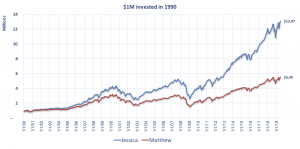A difference in total costs of around 3% per year may cause you to stop earning half of the wealth you could achieve in the long term.
Costs are the despised and forgotten enemy when investing, and yet —as Jack Bogle strongly pointed out for over 40 years— they are one of the most important factors when it comes to investing for the long term.
Costs are usually underestimated because market volatility makes us believe that the “accumulation of small fees” are not so important “with all those opportunities out there”. This false belief is based on the fact that if markets fluctuate around 5% up or down in just a week, it may not be so important to pay a total of around 3% per year in total costs, right?
Wrong. The fact that markets move a lot in the short-term should not make us forget that, in the long term, the returns we can achieve are those of the market —in the range of a high single figure. Annual returns of 20%-30% (as we see from time to time in the press and advertisements) are not sustainable over time and are always temporary (besides the fact that it is impossible to pick in advance what fund will be the next one able to give such returns). Any attempt to pursue higher returns than those of the market is thus either a chimera or a scam.
As Bogle, the SEC and Vanguard pointed out, when we are talking about prudent, realistic long-term annual returns around 7%-9%, a difference in total paid costs of e.g. 3% annually becomes huge. Let’s see it with a simplified example to grasp it:
Imagine that in 1990 Jessica invested $1 million in the S&P-500 index through an index fund with an annual total expense ratio of 0.05%.
At the same time, Matthew, advised by a certified advisor who charges 1.5% annually for picking “the best” active funds, also invested in the Stock Market as an asset class, but through active funds that seek to beat the S&P-500 index and for that it they charge an annual average total expense ratio of 1.5%. All other things being equal, Matthew paid all these years an annual extra 2.95% in costs compared to Jessica. Imagine also that Mathew has been lucky enough to invest in the very few funds that achieve in the long term similar returns as the index (something very rare, as actual results are usually much worse).

After almost 30 years of investing in stocks, the result is that, starting from the same capital and very similar strategy, Jessica has accumulated around $13M. That is more than double the wealth of Matthew, around $5.5M (the gap grows exponentially when adding more years), when both were investing in the same asset class (!).
Matthew wanted to outsmart the markets (and Jessica) and was willing to pay a higher fee, (wrongly)confident that the more you pay for a service, the more you get also in the investing industry.
You have to be extremely careful about the total costs. Reducing fees is critical because in the long term they can make all the difference regarding your lifestyle and expectations. Fortunately —and unlike the other two great enemies, markets and oneself—, it is a very easy factor to solve when you are aware of it and you take care of it.
What the Austrian Investor must always keep in mind is that reducing costs is easier and more attainable than increase returns. As any businessman knows, future returns are unknown, but costs are a sure thing.